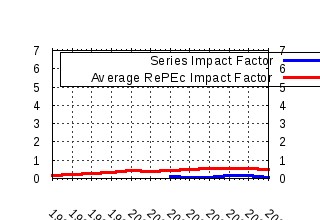
|
|
|||||||||||||||||||||||||||||||||||||||||||||||||||||||||||||||||||||||||||||||||||||||||||||||||||||||||||||||||||||||||||||||||||||||||||||||||||||||||||
Journal of Bioeconomics Raw citation data, Impact Factor, Immediacy Index, Published documents, Citations received, , Most cited papers , Recent citations and documents published in this series in EconPapers.
Most cited documents in this series: (1) RePEc:kap:jbioec:v:2:y:2000:i:3:p:271-273 Religious Groups and Homogeneous Merchant Groups as Adaptive Units: A Multilevel Evolutionary Perspective (2000). (2) RePEc:kap:jbioec:v:5:y:2003:i:2:p:83-96 Skew Selection: Nature Favors a Trickle-Down Distribution of Resources in Ants (2003). (3) RePEc:kap:jbioec:v:10:y:2008:i:3:p:259-278 The bioeconomics of homogeneous middleman groups as adaptive units: Theory and empirical evidence viewed from a group selection framework (2008). (4) RePEc:kap:jbioec:v:7:y:2005:i:2:p:161-178 The Bioeconomics of Marine Reserves: A Selected Review with Policy Implications (2005). (5) RePEc:kap:jbioec:v:6:y:2004:i:2:p:143-163 The Human Adaptation for Culture and its Behavioral Implications (2004). (6) RePEc:kap:jbioec:v:6:y:2004:i:3:p:255-274 Knowledge as a Path-Dependence Process (2004). (7) RePEc:kap:jbioec:v:10:y:2008:i:3:p:203-238 Why multilevel selection matters (2008). (8) RePEc:kap:jbioec:v:2:y:2000:i:3:p:203-220 Survival of the Most Foolish of Fools: The Limits of Evolutionary Selection Theory (2000). (9) RePEc:kap:jbioec:v:9:y:2007:i:3:p:205-225 Towards Sustainability Economics: Principles and Values (2007). (10) RePEc:kap:jbioec:v:8:y:2006:i:2:p:133-145 Corruption and Age (2006). (11) RePEc:kap:jbioec:v:6:y:2004:i:3:p:275-294 Intersubjectivity and Embodiment (2004). (12) RePEc:kap:jbioec:v:5:y:2003:i:2:p:193-214 Ecological Transfers in Non-Human Communities Parallel Economic Markets in a General Equilibrium Ecosystem Model (2003). (13) RePEc:kap:jbioec:v:6:y:2004:i:2:p:165-194 Coexistence of Strategies and Culturally-Specific Common Knowledge: An Evolutionary Analysis (2004). (14) RePEc:kap:jbioec:v:7:y:2005:i:1:p:73-84 The Social Gene (2005). (15) RePEc:kap:jbioec:v:10:y:2008:i:1:p:23-49 Accounting for economic evolution: Fitness and the population method (2008). (16) RePEc:kap:jbioec:v:7:y:2005:i:1:p:1-38 Teaching Bioeconomics (2005). (17) RePEc:kap:jbioec:v:9:y:2007:i:2:p:169-185 Taxonomizing the Relationship Between Biology and Economics: A Very Long Engagement (2007). (18) RePEc:kap:jbioec:v:5:y:2003:i:2:p:151-164 Why Ants Do but Honeybees Do Not Construct Satellite Nests (2003). (19) RePEc:kap:jbioec:v:7:y:2005:i:3:p:221-238 The Economics and Bioeconomics of Folk and Scientific Classification (2005). (20) RePEc:kap:jbioec:v:8:y:2006:i:2:p:121-132 An Analytical Foundation of the Ratio-Dependent Predator-Prey Model (2006). (21) RePEc:kap:jbioec:v:4:y:2002:i:2:p:163-181 A Review of Selected Bioeconomic Models with Environmental Influences in Fisheries (2002). (22) RePEc:kap:jbioec:v:7:y:2005:i:3:p:335-358 The Sensory Order and other Adaptive Classifying Systems (2005). (23) RePEc:kap:jbioec:v:10:y:2008:i:3:p:287-290 Biological and cultural group selection: Comments on Janet Landaâs paper (2008). (24) RePEc:kap:jbioec:v:9:y:2007:i:1:p:69-74 Proximate and Ultimate Utilities: A Rejoinder to Rubin (2007). (25) RePEc:kap:jbioec:v:7:y:2005:i:3:p:215-220 The Economics and Bioeconomics of Classification: Introduction (2005). (26) RePEc:kap:jbioec:v:8:y:2006:i:3:p:219-251 Organizational versus Market Knowledge: From Concrete Embodiment to Abstract Representation (2006). (27) RePEc:kap:jbioec:v:2:y:2000:i:2:p:153-168 The Bioeconomics of Cooperation (2000). (28) RePEc:kap:jbioec:v:8:y:2006:i:1:p:21-33 Sexual Selection and Economic Positioning (2006). (29) RePEc:kap:jbioec:v:10:y:2008:i:3:p:297-301 Demonstrating group selection: A comment on Janet Landaâs âThe bioeconomics of homogenous middleman groups as adaptive unitsâ (2008). (30) RePEc:kap:jbioec:v:9:y:2007:i:2:p:109-144 Synergy Goes to War: A Bioeconomic Theory of Collective Violence (2007). (31) RePEc:kap:jbioec:v:3:y:2001:i:2:p:195-215 Making Good Decisions with Minimal Information: Simultaneous and Sequential Choice (2001). (32) RePEc:kap:jbioec:v:6:y:2004:i:2:p:195-226 Achievement Bias in the Evolution of Preferences (2004). (33) RePEc:kap:jbioec:v:8:y:2006:i:3:p:269-274 The Male-Female Pay Gap Driven by Coupling between Labor Markets and Mating Markets (2006). (34) RePEc:kap:jbioec:v:2:y:2000:i:3:p:233-270 A Bibliography for Bioeconomics (2000). (35) RePEc:kap:jbioec:v:9:y:2007:i:3:p:227-244 Feminist Ecological Economics and Sustainability (2007). (36) RePEc:kap:jbioec:v:10:y:2008:i:1:p:51-69 In search of general evolutionary principles: Why Darwinism is too important to be left to the biologists (2008). (37) RePEc:kap:jbioec:v:8:y:2006:i:3:p:197-218 Charles Kingsley and the Theological Interpretation of Natural Selection (2006). (38) RePEc:kap:jbioec:v:2:y:2000:i:2:p:99-115 Cannibalism and the Optimal Sharing of the North-East Atlantic Cod Stock: a Bioeconomic Model (2000). (39) RePEc:kap:jbioec:v:7:y:2005:i:1:p:39-40 Comment on Robert Yarbroughâs âTeaching Bioeconomicsâ (2005). (40) RePEc:kap:jbioec:v:9:y:2007:i:2:p:85-107 Mind-Dependence. The Past in the Grip of the Present (2007). (41) RePEc:kap:jbioec:v:2:y:2000:i:2:p:139-152 The Ecology of Trade (2000). (42) RePEc:kap:jbioec:v:6:y:2004:i:3:p:295-316 Cognition and Extended (NSNX) Rational Choice: Some Early Results (2004). (43) RePEc:kap:jbioec:v:9:y:2007:i:2:p:145-167 Neuroeconomics as a Natural Extension of Bioeconomics: The Shifting Scope of Standard Economic Theory (2007). Recent citations received in: | 2007 | 2006 | 2005 | 2004 Recent citations received in: 2007 (1) RePEc:kap:copoec:v:18:y:2007:i:4:p:223-241 Imagination and society. The affective side of institutions (2007). Constitutional Political Economy (2) RePEc:kap:jbioec:v:9:y:2007:i:1:p:53-67 Utility, Fitness, and Immigration: Reply to Salter (2007). Journal of Bioeconomics (3) RePEc:kap:jbioec:v:9:y:2007:i:3:p:205-225 Towards Sustainability Economics: Principles and Values (2007). Journal of Bioeconomics Recent citations received in: 2006 Recent citations received in: 2005 Recent citations received in: 2004 (1) RePEc:esi:evopap:2004-15 Darwinism in Economics: From Analogy to Continuity (2004). Max Planck Institute of Economics, Evolutionary Economics Group / Papers on Econonmics and Evolution Warning!! This is still an experimental service. The results of this service should be interpreted with care, especially in research assessment exercises. The processing of documents is automatic. There still are errors and omissions in the identification of references. We are working to improve the software to increase the accuracy of the results. Source data used to compute the impact factor of RePEc series. |
|||||||||||||||||||||||||||||||||||||||||||||||||||||||||||||||||||||||||||||||||||||||||||||||||||||||||||||||||||||||||||||||||||||||||||||||||||||||||||




